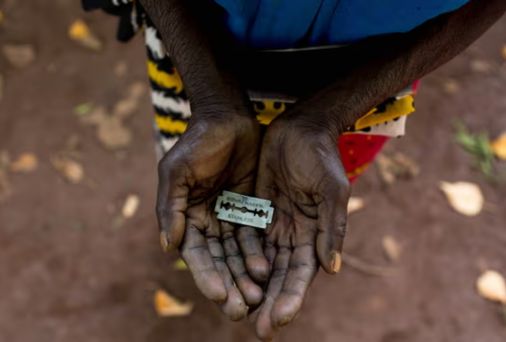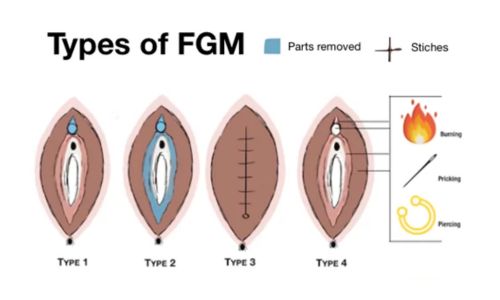What Is FGM?
Female genital mutilation (FGM) is an abhorrent crime against women.
FGM is the partial or total removal of the external female genitalia for non-medical reasons. It’s also known as female circumcision or cutting. FGM is often performed by someone with no medical training who uses instruments such as a knife, scalpel, scissors, glass or razor blade. Children are rarely given anaesthetic or antiseptic treatment and are often forcibly restrained.

The age at which FGM is carried out varies. It may take place:
- When a female baby is new-born
- During childhood or adolescence
- Just before marriage
- During pregnancy
- Adulthood
Where is FGM practiced?
FGM is currently documented in 92 countries around the world through nationally representative data, indirect estimates (usually in countries where FGM is mainly practiced by diaspora communities), small-scale studies, or anecdotal evidence and media reports. This highlights the global nature of this harmful practice and the need for a global and comprehensive response in order to eliminate it.
In Africa, FGM is known to be practiced among certain communities in 33 countries: Benin, Burkina Faso, Cameroon, Central African Republic, Chad, Cote d’Ivoire, Democratic Republic of Congo, Djibouti, Egypt, Eritrea, Ethiopia, Gambia, Ghana, Guinea, Guinea-Bissau, Kenya, Liberia, Malawi, Mali, Mauritania, Niger, Nigeria, Senegal, Sierra Leone, Somalia, South Africa, South Sudan, Sudan, Tanzania, Togo, Uganda, Zambia and Zimbabwe Certain ethnic groups in Asian countries practice FGM, including in communities in India, Indonesia, Malaysia, the Maldives, Pakistan and Sri Lanka.
In the Middle East, the practice occurs in Oman, the United Arab Emirates and Yemen, as well as in Iraq, Iran, Jordan and the State of Palestine.
In Eastern Europe, recent info shows that certain communities are practicing FGM in Georgia and the Russian Federation.
In South America, certain communities are known to practice FGM in Colombia, Ecuador, Panama and Peru.
And in many western countries, including Australia, Canada, New Zealand, the United States, the United Kingdom and various European countries, FGM is practiced among diaspora populations from areas where the practice is common.
Where does the practice come from

Why is FGM performed?
In every society in which it is practiced, female genital mutilation is a manifestation of deeply entrenched gender inequality. Where it is widely practiced, FGM is supported by both men and women, usually without question, and anyone that does not follow the norm may face condemnation, harassment and ostracism. It may be difficult for families to abandon the practice without support from the wider community.
The reasons given for practicing FGM fall generally into five categories:
Psychosexual reasons:
FGM is carried out as a way to control women’s sexuality, which is sometimes said to be insatiable if parts of the genitalia, especially the clitoris, are not removed. It is thought to ensure virginity before marriage and fidelity afterward, and to increase male sexual pleasure.
Sociological and cultural reasons:
FGM is seen as part of a girl’s initiation into womanhood and as an intrinsic part of a community’s cultural heritage. Sometimes myths about female genitalia (e.g., that an uncut clitoris will grow to the size of a penis, or that FGM will enhance fertility or promote child survival) perpetuate the practice.
Hygiene and aesthetic reasons:
In some communities, the external female genitalia are considered dirty and ugly and are removed, ostensibly to promote hygiene and aesthetic appeal.
Religious reasons:
Although FGM is not endorsed by either Islam or by Christianity, supposed religious doctrine is often used to justify the practice, even though it is not found in any of the Holy or religious books.
Socio-economic factors:
In many communities, FGM is a prerequisite for marriage. Where women are largely dependent on men, economic necessity can be a major driver of the procedure. FGM sometimes is a prerequisite for the right to inherit. It may also be a major income source for practitioners.
National FGM Centre – Traditional Terms for Female Genital Mutilation – FGM Terminology for Website.pages (nationalfgmcentre.org.uk)
Types of FGM
Type 1
Clitoridectomy – removing part or all of the clitoris.
Type 2
Excision – removing part or all of the clitoris and cutting the inner and/or outer labia.
Type 3
Infibulation – narrowing the vaginal opening.
Type 4
Other harmful procedures to the female genitals including pricking, piercing, cutting, scraping or burning.

An estimated 200 million girls and women alive today have undergone FGM.
- Somalia
- Sierra Leone
- Eritrea
- Indonesia
- Malaysia
- Kenya
- Egypt
- Ethiopia
- Ivory Coast
- Mali
- Sudan
- Nigeria
- Gambia
- Liberia
- Yemen
Learn More About FGM
- FGM is abuse. It has no health benefits whatsoever and can have terrible and lasting physical, psychological, and emotional consequences.
- The NHS warns that infections and excessive bleeding are common consequences of the procedures, both of which can be deadly.
- Death can occur as a direct result of being cut. These deaths can be caused by a range of complications, including haemorrhage, contracting septicaemia, tetanus, or HIV, due to unsterilised tools. A girl will also experience shock, fear, pain and trauma.
- After undergoing FGM, a girl can experience difficulty in passing urine and difficulties with menstruation, because her urethra and/or vaginal opening may have been blocked through FGM. This can lead to chronic urinary infections and chronic pelvic inflammation. They may also suffer from cysts, abscesses and ulcers after being cut.
- Young girls who are subjected to FGM may also suffer educationally. Health problems resulting from FGM can cause them to miss school/college/university, leading to poor achievements, which will economically disadvantage them later in their lives. FGM is also often a precursor to child marriage.
- With all types of FGM, sex can be painful and traumatic. Women and girls who have undergone FGM Type 3 will often have to be re-cut to have sex or may experience forced penetration. It is not only the first time that is painful. For many women, scar tissue will continue to cause pain during sex throughout their lifetimes, whilst their partners may also experience pain and trauma during sex.
- After a girl/young woman is cut, there can be an increased risk of infertility, which within some communities may cause her to be abandoned by her husband.
- FGM has a direct impact on maternal and infant mortality. Women who have undergone FGM Type 3 are 70% more likely to suffer haemorrhage through giving birth. They are twice as likely to die in childbirth and have a higher likelihood of stillbirth due to obstructed labour. Women who have undergone FGM Type 3 are also more likely to experience other complications including obstetric fistula, foetal asphyxia, and perineal tears.
In every society in which it is practiced, female genital mutilation is a manifestation of deeply entrenched gender inequality. Where it is widely practiced, FGM is supported by both men and women, usually without question, and anyone that does not follow the norm may face condemnation, harassment and ostracism. It may be difficult for families to abandon the practice without support from the wider community.
The reasons given for practicing FGM fall generally into five categories:
Psychosexual reasons:
FGM is carried out as a way to control women’s sexuality, which is sometimes said to be insatiable if parts of the genitalia, especially the clitoris, are not removed. It is thought to ensure virginity before marriage and fidelity afterward, and to increase male sexual pleasure.Sociological and cultural reasons:
FGM is seen as part of a girl’s initiation into womanhood and as an intrinsic part of a community’s cultural heritage. Sometimes myths about female genitalia (e.g., that an uncut clitoris will grow to the size of a penis, or that FGM will enhance fertility or promote child survival) perpetuate the practice.Hygiene and aesthetic reasons:
In some communities, the external female genitalia are considered dirty and ugly and are removed, ostensibly to promote hygiene and aesthetic appeal.Religious reasons:
Although FGM is not endorsed by either Islam or by Christianity, supposed religious doctrine is often used to justify the practice, even though it is not found in any of the Holy or religious books.Socio-economic factors:
In many communities, FGM is a prerequisite for marriage. Where women are largely dependent on men, economic necessity can be a major driver of the procedure. FGM sometimes is a prerequisite for the right to inherit. It may also be a major income source for practitioners.National FGM Centre – Traditional Terms for Female Genital Mutilation – FGM Terminology for Website.pages (nationalfgmcentre.org.uk)
- Practising FGM is a criminal offence in the UK!
- FGM has been illegal since 1985 – current legislation – Female Genital Mutilation Act 2003
- UK law stipulates that it is illegal to help, support or arrange for FGM to be performed on a girl in this country!
- Equally, it is also illegal to take a girl outside the UK to have FGM carried out!
- It is illegal to support or assist a female to carry out FGM on herself.
- Section 72 of The serious Crime Act 2015 includes a Failure to protect when you have a safeguarding duty.
- This means that if a girl under the age of 16 is subjected to FGM, then each person who is responsible for the girl at that time, will be held liable to prosecution!
- This includes teaching staff and other professionals
- And parents who use excuse such as, I only sent her for a holiday, I did not know my mother in-law was going to do it or I was not there, etc, etc
The offence of FGM can result in up to 14 years in prison!
Latest UK Conviction – Woman convicted of taking British girl, three, for female genital mutilation in Kenya | Female genital mutilation (FGM) | The Guardian
See CPS link for further information on FGM and the law Female Genital Mutilation | The Crown Prosecution Service (cps.gov.uk)
- National FGM Risk Assessment Tool
- FGM Safeguarding Pathway
- FGM Safeguarding and Risk Assessment guide for health care professionals
You Are Not Alone https://1drv.ms/b/s!AmTM_qKm6bBz-kxr6ICE1fy820-Z?e=aR3ZBe
Help & Support https://1drv.ms/b/s!AmTM_qKm6bBz-QsZ91ZBplAnGKcg?e=VansO9
Calling all Men https://1drv.ms/b/s!AmTM_qKm6bBz-k5we7HkCo-bF87v?e=43fssa
Summer Campaign https://1drv.ms/b/s!AmTM_qKm6bBzpl5nbaJZ9Q84mV9D?e=jh1hYv
Stand Against FGM https://1drv.ms/b/s!AmTM_qKm6bBzgTtWdsu_6Cpp8SXA?e=jcPs7x
Summer Campaign https://1drv.ms/b/s!AmTM_qKm6bBz9D5loD16unuJaKJN?e=1r4fGL
Faith Groups Stand Together https://1drv.ms/p/s!AmTM_qKm6bBzknVYDYAmkS6LpILR?e=oFcaek
End FGM https://1drv.ms/b/s!AmTM_qKm6bBzgX2DiL9OBQivuBzA?e=QYfbpX
DORCAS services https://1drv.ms/i/s!AmTM_qKm6bBzpjcafs-E8Bpw1IXq?e=TgdlDG
Help & Support https://1drv.ms/b/s!AmTM_qKm6bBzwETjQbBbvnx0i2Ot?e=81FzRy
Teens https://1drv.ms/b/s!AmTM_qKm6bBzgToTS_b4D0M_klyC?e=Mdg3bo
